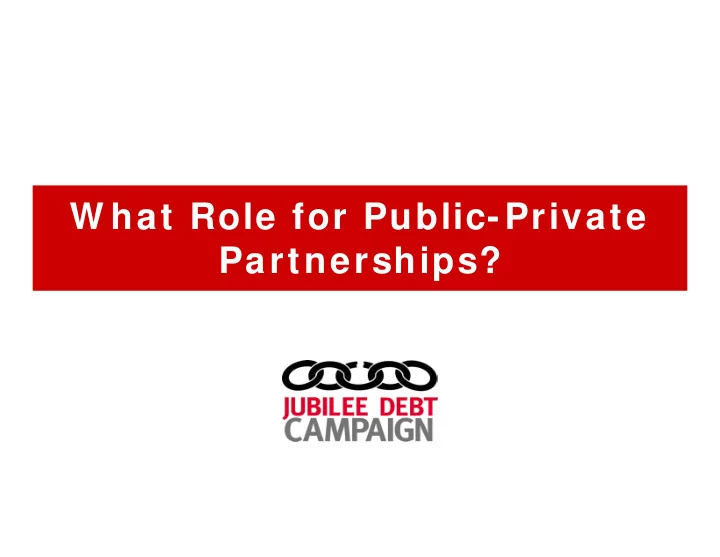

W hat Role for Public-Private Partnerships?
W hat is a PPP?
Definition of a PPP Key features: • Rather than the government borrowing money to invest in infrastructure /services such as a road or hospital, PPPs enable the private sector to borrow the money instead , whilst the government commits to a set level of payments to the private sector. • Ownership varies • Government guarantees – Risk remains with the public sector
Do they w ork? • Some high profile success stories: GAVI, HIV/Aids Alliance – not without criticism • Overall very weak evidence base in support of the benefits of PPPs for development and value for money for the public sector. • Of 442 PPPs supported by the World Bank, assessments of their impact on poverty have been conducted for just 9 of them (2%), and of their fiscal impact for just 12 (3%).
Concerns w ith PPPs: 1 . Cost Effectiveness “Given the limited evidence we are not able to indicate the benefits of PPPs compared to the costs. Further research is needed to answer this question” (Public-Private Partnerships in developing countries: A systematic literature review, IOB Study, Ministry of Foreign Affairs of the Netherlands, April 2013, page 43)
Concerns w ith PPPs: 1 . Cost Effectiveness PPPs are by far the most expensive way to fund projects . (Griffiths et al (2014). Financing for development post 2015: Improving the contribution of private finance, Jesse Griffiths, Matthew Martin, Javier Pereira and Tim Strawson, requested by the European Parliament’s Committee on Development and published by Directorate-General for External Policies of the Union, 9 April 2014, p34)
Concerns w ith PPPs: 1 . Cost Effectiveness “The use of PFI has the effect of increasing the cost of finance for public investments relative to what would be available to the government if it borrowed on its own account.” “We do not believe that PFI can be relied upon to provide good value for money without substantial reform.” (Treasury Select Committee,, UK Parliament (2011): Private Finance Initiative: Conclusions and Recommendations, http://www.publications.parliament.uk/pa/cm201012/cmselect/cmtreasy/11 46/114608.htm
Concerns w ith PPPs: 1 . Cost Effectiveness Costs are likely to be higher than if the government borrowed directly because: • Private borrowing: The interest rate paid by the private sector is higher • For-profit orientation: The private borrower / provider demands a (high) rate of profit • High transaction costs, e.g. legal fees • Weak procurement decision-making: The private sector has consistently negotiated better deals for itself than the government.
Concerns w ith PPPs: 2 . Fiscal risks “They represent direct and contingent liabilities for the public sector but play an important role from the private sector perspective, as they help mitigate risks and can alter the financial viability of a PPP business case.” (The Independent Evaluation Group of the World Bank: (Undated). World Bank Group Support to Public-Private Partnerships: Lessons from Experience in Client Countries, fy02–1202–12.)
Concerns w ith PPPs: 2 . Fiscal risks The fiscal risks of PPPs are “potentially large” because they can be used to: •“move spending off budget and bypass spending controls ” •“ move debt off balance sheet and create contingent and future liabilities ” •And they “ reduce budget flexibility in the long term ” (Queyranne, M. (2014) – IMF Fiscal Affairs Dept: Managing Fiscal Risks from Public-Private Partnerships. Presentation in Yaounde, March 2014)
Concerns w ith PPPs: 2 . Fiscal risks Renegotiations are common and tend to favour private-sector operators: •55% of PPPs get renegotiated, on average every 2 years •Of renegotiations, 62% involve an increase in tariffs, 69% a postponement or decrease in private sector obligations, and 31% a cut in fees paid to governments (Queyranne, M. (2014) – IMF Fiscal Affairs Dept: Managing Fiscal Risks from Public-Private Partnerships. Presentation in Yaounde, March 2014)
Concerns w ith PPPs: 2 . Fiscal risks IMF: “In practice, about one-fifth of the largest unexpected increases in general government gross debt during 2007–10 were due to government support to the financial sector and hidden or implicit obligations to public corporations and public-private partnerships outside the general government perimeter.” http://www.imf.org/external/pubs/ft/fm/2013/01/p df/fm1301.pdf
Concerns w ith PPPs: 2 . Fiscal risks ‘Buy now, pay (MORE) later’ = Transfer of costs from current generation to future generations.
Case Studies: Health 1. Mamohato Memorial Hospital, Lesotho 2. Lewisham hospital Riverside PFI , United Kingdom
Concerns w ith PPPs: Sum m ary • Management burdens and inadequate evidence of value added • Distortion of development priorities • Disadvantage to Least-Developed Countries and individuals • Unfair advantage to private partners • Bad bedfellows (by which they mean risk of association with disreputable private entities) • Threat to American jobs (CRS (2011). Foreign Assistance: Public-Private Partnerships (PPPs), CRS Report for US Congress, Marian Leonardo Lawson, Congressional Research Services 13 June 2011, p12)
Recommend
More recommend